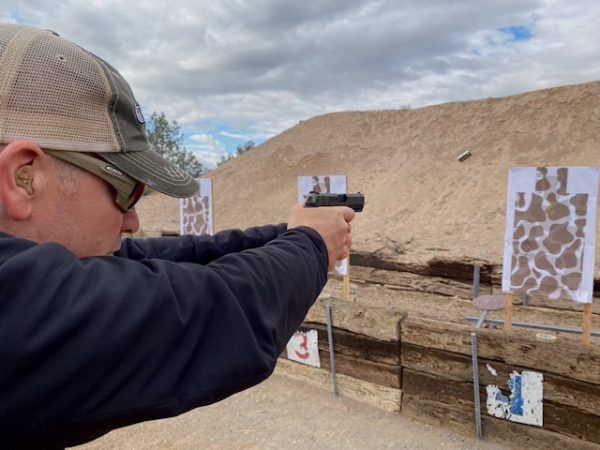I’m at Gunsite Academy this week for testing of new products (sorry, can’t say more, but I’m impressed). We do much of our testing via modified shooting drills from Gunsite’s 250 Pistol Class under the eye of Gunsite’s instructor corps. The drills are modified a bit because we’re here to test and evaluate new products, not train.
But the training part of the drills is never a bad thing.
Gunsite’s 250 class is designed to move you gradually to the point you’re proficient enough with your gun that “normal” shooting tasks to handle basic operations (“load and make ready”). From there, you move into learning remedies for dealing with the unexpected issues that sometime happen with all mechanical devices.
We’ve drilled for stoppages, reloads, and lots of repetitions of the seemingly simple acts of drawing, presenting and firing a pistol- rapidly and accurately, then safely re-holstering.
Putting the “rapidly” and “accurately” together is more difficult than it should be if you’ve been less than diligent about keeping your skills sharp. If you’re overly familiar with shooting, you may realize you’ve gotten a bit lax in your safety awareness.
In short, it’s a great opportunity to knock the rust off your basic skills while doing your real job.
Most of us overestimate our abilities to do some things, but it’s the opposite problem when we try to do something that deteriorates without practice. There’s nothing like drawing and firing a single shot to a particular section of the target alongside fellow shooters to see that you’re not as sharp as you should be. Shooting in a group isn’t anything like the loss of fine motor skills that accompanies an adrenaline dump, but it’s enough to make you conscious of just how raggedly you’re doing things you thought you could do smoothly.
Ramp it up to include multiple shots to different target areas within time parameters, and everything except the front sight comes into focus really quickly. Especially when you watch the accomplished shooters doing their thing.
Running unfamiliar guns through somewhat familiar drills helps you determine if a gun is “user friendly”. Doing in a group lets you compare your impressions with other writers/shooters in attendance.
This week, as we’ve run our drills with assigned guns, we’ve learned how quickly you develop a “feel” for “your” gun. A couple of us decided to swap guns for some of the drills. And we realized that the guns “felt” different for several shots.
The takeaway from our little experiment? The difference is stock guns is largely in the mind of the shooter, not variables in the guns.
That’s good news for everyone -especially the manufacturer watching our reactions. The differences are minuscule, but your body is far more perceptive than you think.

There are always some useful tricks you can pick up from watching others. Chris Cerino, for example, offered (again) a time-proven tip that helps my aging eyes that occasionally struggle to find the all-important front sight. He took a sharpie and blacked out the two rear dots on the test gun’s sights (this gun will be offered with three-dot sights). Blacking out the rear dots helps me avoid the confusion of having to hunt the front (center) dot. I align the dot inside the black bars and know I’m on target.
Gunsite Instructor Mario Marchman helped with another problem I battle: widening groups over the course of a session. As usual, the problem wasn’t hardware -it was software.
After running drills for a while, I lose focus. And when I start looking at the target instead of the front sight, I seldom like what I see.
Having become accustomed to using red dots and laser sights, I’ve forgotten iron sights present a challenge for my eyes anymore. So....if I lose the focus on the front sight, I shift to the target. It looks like I’m “peeking” over my sights, but I’m actually looking around them at my full-field of vision- trying to see a red/green dot that’s not there.
That’s another reason why fundamentals are essential. It’s also why the provision to add red dot sights and lasers have become requirements for many gun shoppers.
Everyone should train with until the correct manipulation of their gun becomes a matter of unconscious habit, not your undivided attention. For everyone, that means repetition. For others of us, it means realizing you need optical sights.

Going through these test and evaluation sessions sounds like fun, and I’m not going to claim it isn’t. The opportunity to enjoy something you enjoy in the company of friends - while still learning - is terrific.
But if you’re doing your job -which is evaluating a new product and trying to find its strong points and potential weaknesses, you come back to your hotel at the end of the day looking forward to an opportunity to get out of your gear, put your feet up, rehydrate and rest.
After all, you’re going to be doing it again tomorrow. There’s more than one new product to test.
We’ll keep you posted.
—Jim Shepherd